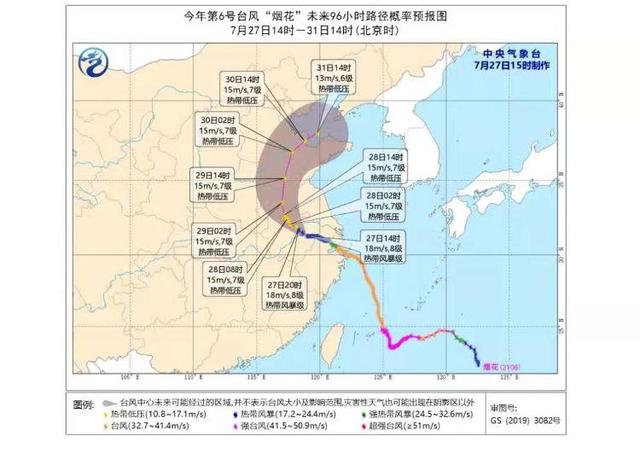Meteorologists analyze the typhoon "fireworks": they walk slowly and fickle, and may not be as "powerful" as Lichima.
Public Network Poster Journalist Liang Wen Jinan Report
Typhoon "Fireworks" has started to affect Shandong since yesterday. According to the forecast issued by Shandong Meteorological Bureau at 15: 00 on July 27th, the center of "Fireworks" will enter our province from Lunan in the early morning of 29th, and enter Bohai Sea from Binzhou to Dongying on 30th. Why does the "fireworks" travel slowly and the path changes again and again? Which areas of Shandong will be mainly affected by the transit of "fireworks"? On the afternoon of July 27th, the poster journalist of Dazhong.com interviewed Hou Shumei, chief forecaster of Shandong Meteorological Bureau, and listened to meteorologists analyze the typhoon "fireworks".

Hou Shumei introduced that the biggest feature of the No.6 typhoon "Fireworks" this year is slow. Before landing at sea, the "fireworks" moved slowly, and the path changed again and again, and the path could be said to be "strange".
"At first, we thought it might come north or turn around and go south." Hou Shumei explained that this happened mainly because steering flow, the "fireworks", was not obvious, just between the offshore subtropical high and the inland continental high, and steering flow was very weak, so there was no obvious force to lead it, so sometimes the "fireworks" didn’t walk for a day in the early stage, and the distance was very small. "This situation is more difficult for forecasting." Hou Shumei said that the moving speed of "fireworks" is still relatively slow, but it may be faster than the previous speed after turning to the north in the future.
At present, the peripheral cloud system of "fireworks" has begun to affect Shandong and bring precipitation. According to the forecast of Shandong Meteorological Bureau at 15: 00 on July 27th, there will be heavy rainfall from south to north in our province from today’s night to 30th, and there will be heavy rain to heavy rain in southern Shandong, central Shandong and northwestern Shandong, and moderate to heavy rain in the peninsula. The heavy precipitation period is from the day of 28th to the night of 29th. The cumulative average precipitation in the whole province is 80 ~ 120mm, and the maximum rainfall intensity in Jining, Zaozhuang, Linyi, Rizhao, Jinan, Tai ‘an, Zibo, Weifang, Liaocheng, Dezhou, Binzhou, Dongying and Qingdao is 100 ~ 150mm, and the local area is more than 250mm, and the maximum rainfall intensity in one hour is 60 ~ 80mm. Heze, Qingdao, 50 ~ 80 mm in the east, more than 100 mm in some areas; Yantai and Weihai are 10 ~ 30 mm, and locally more than 50 mm (Figure 2). At the same time, the wind gradually increases from south to north, with 7-8 grades in the central Yellow Sea, Bohai Sea, Bohai Strait and northern Yellow Sea, 9-10 grades in gusts, 6-7 grades in inland areas and 8-9 grades in local gusts.

Through the real-time route map of "Fireworks", we can see that after the center of "Fireworks" moves into Shandong, it may go deep into southern Shandong, covering the whole of Shandong. Hou Shumei said that typhoons that went deep into southern Shandong were rare for many years, but they appeared more in the past two years. For example, the typhoons Capricorn and Wambia in 2018, and the typhoon Lichima in 2019. From the path, the moving path of "Lichima" in Shandong is eastward, and the path similar to that of "Fireworks" is "Wambia". Hou Shumei said that "Wambia" came in from Heze to Zaozhuang at that time and entered the sea from Dongying, which had a serious impact on Shandong.
Compared with "Wambia" and "Lichima", what is the influence of "fireworks" on Shandong? Hou Shumei said that it is impossible to rule out the possibility that the precipitation brought by "fireworks" will break through the historical extreme value at present, but from the analysis of the current situation, the conditions of "fireworks" are not as favorable as those of "Wambia". As the fireworks are gradually pushed northward in the later period, how the circulation evolves still needs attention. In addition, Hou Shumei said that "fireworks" is different from "Lichima". At present, there is no sign that the degree of rainfall caused by "fireworks" will exceed that of "Lichima", but this possibility cannot be ruled out. "With the approach of’ fireworks’, we need to continue to pay attention."
Reporting/feedback